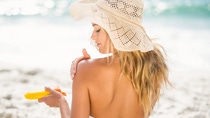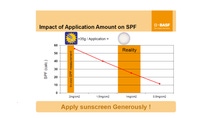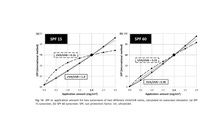Debunking sunscreen myths part 5

Another myth is to do with the application amount of sunscreen and value of SPF we enjoy from it.
This myth has been spread often by ‘experts’, from which we often hear: ‘If you use a half the volume of SPF, then you actually only enjoy a square root of the SPF value.’
In other words, if you apply a sunscreen of SPF 16 and apply only 1.0mg/cm2 (which is half of the suggested 2.0mg/cm2) then you would only enjoy a value of SPF 4. If this really was a fact, then paired with how low our compliance with correct sunscreen application is known to be, we may have a reason to be very concerned.
But is this the truth?
This myth originated from two scientists who found in-vivo that the relationship between SPF-to-application-amount resulted in a convex shaped graph. So, according to their experiment, the relationship had to be an exponential one[1].
Scientists at BASF were naturally perplexed; why was this so? There had to be a reason - so in the spirit of discovery, they looked over all documents and their methodical rigour paid off…They discovered that this experiment actually only took account of UVB rays when counting SPF. However, we know that SPF also needs to block UVA rays. Seeing that most common sunscreens are very good at blocking UVB, it is no surprise that they found an exponential relationship.
Remember, SPF doesn’t just need to block UVB, it also needs to block UVA because UVA also contributes to erythema, sunburn and skin cancer!
So, what is the relationship between SPF value and application?
Scientists at BASF ran numbers and trials through the sunscreen simulator[2] and discovered that this relationship between commonly found SPF UVB biased sunscreen was neither concave or convex - it is actually quasi-linear. Figure 14a shows two cases with different SPF 15 sunscreens. One of them was UVB protection biased (UVA:UVB=0.16), while the other was a case where UVA-UVB is uniform (UVA/UVB=1.0). This result is further confirmed by the two SPF 60 sunscreens (fig. 14b.). The concave curve of the line due to UVB bias (UVA/UVB=0.33) is less pronounced because higher SPFs take into account UVB and UVA rays. This is how we can confidently say that the relationship between SPF and application amount is quasi-linear, not exponential.


This was then further confirmed by the German Cosmetics Society and a US based study[3,4]. The German study found that in three ring in-vivo tests with SPF 25 sunscreens, the SPF measured at 0.5mg/cm2 was on average around a quarter and at 1.0mg/cm2 around half the standard SPF measured at 2.0mg/cm2. The US study used SPFs of 70 and 100 and further found a linear relationship between SPF and application amount. Sunscreen labelled at SPF 70 and SPF 100 applied at 0.5mg/cm2 provided an actual SPF value of 19 and 27 respectively. These results can be simulated on the sunscreen simulator. Besides the standard application amount of 2.0mg/cm2, other amounts that can be chosen are 0.5, 1.0, 1.5, 2.5 and 3.0mg/cm2.
However, we found that there were discrepancies between the American in-vivo calculated SPF value and the values calculated on the sunscreen simulator; the American calculation would generally yield a higher value. Strangely, this cannot be explained by differing test methods between the American FDA on one hand, and Cosmetic Europe, International Standardisation Organisation (ISO) testing methods on the other. European sunscreens tested in Europe are well in line with the calculations made on the simulator.
Fact:
Overall, both in-vivo test results and those yielded by the sunscreen simulator (in-silico) show a linear relationship between SPF value and application amount. This means that while SPF value is substantially reduced when we do not apply enough sunscreen (as well as in a correct evenly spread manner), it is not exponentially reduced to a mere square root! What these results do tell us is that it’s always better to choose a sunscreen with the highest SPF available.
*Always read the label, use only as directed.
Interested in learning more? Contact us so we can share our insight and expertise in developing solutions for the sunscreen industry.
®/TM Registered trademark. All rights reserved.
REFERENCE
1. Faurschou A, et al. The relation between sun protection factor and amount of sunscreen applied in vivo, Brit. J. Dermatol 2007;157:716-719
2. Anonymous, BASF Sunscreen simulator, BASF SE, Ludwigshafen, Germany,2010. Available at http://www.basf.com//sunscreen-simulator. Assessed 18 Oct. 2013
3. Bimczok R., et al. Influence of applied quantity of sunscreen products on the sun protection factor-a multicenter study organized by the DGK taskforce sun protection. Skin pharmacol Physiol 2007;20:57-64
4. Ou-Yang H., et al. High-SPF sunscreens(SPF≥70) may provide ultraviolet protection above minimal recommended levels by adequately compensating for low sunscreen user application amounts. J.Am. Acad.Dermatol 2012;67:1220-1227